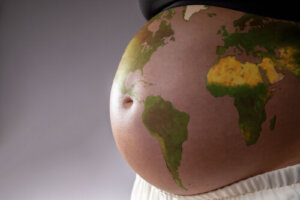How Climate Change Affects Pregnancy


Written and verified by the nurse Leidy Mora Molina
Climate change is one of the greatest threats to the health of the population today. Even more so in vulnerable groups, such as pregnant women, where its effects increase the risk of complications and compromise the well-being of mother and baby.
Certainly, during pregnancy, the woman’s body makes drastic changes to promote the welfare of her baby. This increases their susceptibility to environmental factors that can directly or indirectly affect her health. Below, we’ll tell you how climate change affects this important stage.
Climate change and pregnancy
In recent years, we’ve heard about how climate change can bring unfavorable consequences for the population. The United Nations (UN) defines this climate effect as follows:
“The climate change attributed directly or indirectly to human activity that alters the composition of the global atmosphere and that is in addition to natural climate variability observed over comparable time periods.”
In this sense, different natural phenomena, such as forest fires, extreme heat waves, hurricanes, floods, and droughts, result from this environmental problem and affect the quality of the air, water, and food we consume.
Pregnant women, in particular, are subject to hormonal variations that make them vulnerable to any event that occurs around them. As a result, they’re more likely to develop infections, hyperthermia, dehydration, hypertension, or diabetes, among other diseases.
Let’s take a closer look at how climate change can affect pregnancy.
Temperature increase

During pregnancy, the action of estrogens and progesterone favors increased blood flow and body vasodilation. These effects produce a physiological increase in temperature and affect the woman’s body thermoregulation.
However, heat waves and the increase in environmental temperature caused by climate change accentuate this alteration. This increases the risk of overheating in pregnant women, which can lead to dehydration and, in advanced cases, renal failure.
Maternal hyperthermia also increases the risk of fetal alterations such as anatomical malformations, fetal growth problems, and premature delivery.
Research published in the journal The Lancet, entitled “The impact of high environmental temperatures on the timing of delivery and gestational length,” found that extreme heat causes an increase in preterm deliveries that are shortened by six days to two weeks as a result.
Respiratory disturbances
Air pollution also negatively influences the well-being of pregnancy. Alterations in the mother’s cardiopulmonary health and placental damage are the consequence of particles from the combustion of fossil fuels, automobiles, and forest fires. This is stated by the International Federation of Gynecologists and Obstetricians FIGO, in its article entitled “Climate change, women’s health and the role of obstetricians and gynecologists in leadership”.
“Certainly this affectation in the lungs, heart and placenta of the mother, favors the development of arterial hypertension and thus, the risk of suffering from preeclampsia and eclampsia”.
In turn, the decrease in oxygen supply to the fetus and the passage of these pollutants through the placenta increases the incidence of miscarriages, premature births, low birth weight in babies, and babies with alterations in cognitive capacity.
Compromised nutrition
Hurricanes, rains, floods, or droughts affect food production and quality. This translates into nutritional deficits for the pregnant woman and consequences such as diarrhea and secondary infections due to the consumption of contaminated food.
These are some of the consequences that can be triggered by gestational problems:
- Malnutrition
- Anemia
- Dehydration
- Severe infections
- Fetal malformations
- Spontaneous miscarriages
- Fetuses with growth problems
- Low birth weight in babies

Stress
Pregnant women are more prone to suffer from stress due to the hormonal cocktail they’re dealing with. Evidently, this stress increases during major weather events such as heat waves, hurricanes, or floods. These conditions can generate post-traumatic stress and other problems such as depression.
Infectious diseases
Natural disasters arising from climate change can exacerbate and spread infectious diseases related to food, water, and insects, such as dengue fever, Zika or schistosomiasis, to name a few.
Pregnant women are a risk group, as, throughout pregnancy, the immune system is suppressed to avoid the rejection of the fetus.
Can these effects on pregnancy be avoided?
In many cases, it’s difficult to prevent the effects of climate change on pregnant women. However, timely medical attention and regular prenatal care can mitigate the severity of these effects.
In this regard, prenatal care allows early diagnosis and treatment of the possible consequences of this problem. In this way, the negative effects on the mother and fetus are reduced.
In recent years, some health associations, such as the American College of Obstetricians and Gynecologists (ACOG), have recognized the urgent need to seek large-scale solutions to curb climate change and its effects on people’s health.
Climate change is one of the greatest threats to the health of the population today. Even more so in vulnerable groups, such as pregnant women, where its effects increase the risk of complications and compromise the well-being of mother and baby.
Certainly, during pregnancy, the woman’s body makes drastic changes to promote the welfare of her baby. This increases their susceptibility to environmental factors that can directly or indirectly affect her health. Below, we’ll tell you how climate change affects this important stage.
Climate change and pregnancy
In recent years, we’ve heard about how climate change can bring unfavorable consequences for the population. The United Nations (UN) defines this climate effect as follows:
“The climate change attributed directly or indirectly to human activity that alters the composition of the global atmosphere and that is in addition to natural climate variability observed over comparable time periods.”
In this sense, different natural phenomena, such as forest fires, extreme heat waves, hurricanes, floods, and droughts, result from this environmental problem and affect the quality of the air, water, and food we consume.
Pregnant women, in particular, are subject to hormonal variations that make them vulnerable to any event that occurs around them. As a result, they’re more likely to develop infections, hyperthermia, dehydration, hypertension, or diabetes, among other diseases.
Let’s take a closer look at how climate change can affect pregnancy.
Temperature increase

During pregnancy, the action of estrogens and progesterone favors increased blood flow and body vasodilation. These effects produce a physiological increase in temperature and affect the woman’s body thermoregulation.
However, heat waves and the increase in environmental temperature caused by climate change accentuate this alteration. This increases the risk of overheating in pregnant women, which can lead to dehydration and, in advanced cases, renal failure.
Maternal hyperthermia also increases the risk of fetal alterations such as anatomical malformations, fetal growth problems, and premature delivery.
Research published in the journal The Lancet, entitled “The impact of high environmental temperatures on the timing of delivery and gestational length,” found that extreme heat causes an increase in preterm deliveries that are shortened by six days to two weeks as a result.
Respiratory disturbances
Air pollution also negatively influences the well-being of pregnancy. Alterations in the mother’s cardiopulmonary health and placental damage are the consequence of particles from the combustion of fossil fuels, automobiles, and forest fires. This is stated by the International Federation of Gynecologists and Obstetricians FIGO, in its article entitled “Climate change, women’s health and the role of obstetricians and gynecologists in leadership”.
“Certainly this affectation in the lungs, heart and placenta of the mother, favors the development of arterial hypertension and thus, the risk of suffering from preeclampsia and eclampsia”.
In turn, the decrease in oxygen supply to the fetus and the passage of these pollutants through the placenta increases the incidence of miscarriages, premature births, low birth weight in babies, and babies with alterations in cognitive capacity.
Compromised nutrition
Hurricanes, rains, floods, or droughts affect food production and quality. This translates into nutritional deficits for the pregnant woman and consequences such as diarrhea and secondary infections due to the consumption of contaminated food.
These are some of the consequences that can be triggered by gestational problems:
- Malnutrition
- Anemia
- Dehydration
- Severe infections
- Fetal malformations
- Spontaneous miscarriages
- Fetuses with growth problems
- Low birth weight in babies

Stress
Pregnant women are more prone to suffer from stress due to the hormonal cocktail they’re dealing with. Evidently, this stress increases during major weather events such as heat waves, hurricanes, or floods. These conditions can generate post-traumatic stress and other problems such as depression.
Infectious diseases
Natural disasters arising from climate change can exacerbate and spread infectious diseases related to food, water, and insects, such as dengue fever, Zika or schistosomiasis, to name a few.
Pregnant women are a risk group, as, throughout pregnancy, the immune system is suppressed to avoid the rejection of the fetus.
Can these effects on pregnancy be avoided?
In many cases, it’s difficult to prevent the effects of climate change on pregnant women. However, timely medical attention and regular prenatal care can mitigate the severity of these effects.
In this regard, prenatal care allows early diagnosis and treatment of the possible consequences of this problem. In this way, the negative effects on the mother and fetus are reduced.
In recent years, some health associations, such as the American College of Obstetricians and Gynecologists (ACOG), have recognized the urgent need to seek large-scale solutions to curb climate change and its effects on people’s health.
All cited sources were thoroughly reviewed by our team to ensure their quality, reliability, currency, and validity. The bibliography of this article was considered reliable and of academic or scientific accuracy.
- Ha, S. (2022) The Changing Climate and Pregnancy Health. Current environmental health reports 9(2):263-275. Recuperado de: https://pubmed.ncbi.nlm.nih.gov/35194749/
- International federation of gynecology and obstetrics (2021). El cambio climático, la salud de la mujer y el papel de los obstetras y ginecólogos en el liderazgo. Recuperado de: https://www.figo.org/es/noticias/cambio-clim%C3%A1tico-salud-de-mujeres-rol-obgyn-liderazgo
- Kuehn, L. McCormick S. (2017). Heat Exposure and Maternal Health in the Face of Climate Change. Int. J. Environ. Res. Public Health 2017, 14(8), 853. Recuperado de: https://www.mdpi.com/1660-4601/14/8/853/htm
- The american college of obstetricians and gynecologist (2018). Addressing Climate Change. Recuperado de: https://www.acog.org/clinical-information/policy-and-position-statements/position-statements/2021/addressing-climate-change
- United states environmental protection agency (2016) El cambio climático y la salud de las embarazadas. EPA 430-F-16-056. Recuperado de: https://19january2017snapshot.epa.gov/sites/production/files/2016-10/documents/pregnant-health-climate-change-sp.pdf
This text is provided for informational purposes only and does not replace consultation with a professional. If in doubt, consult your specialist.








